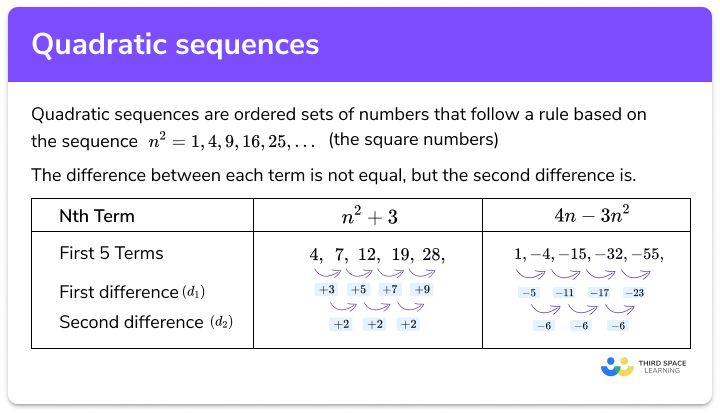

1 Find the first difference (d 1) and second difference (d 2) for the sequence. For example, the 50th term can be calculated without calculating the first 49 terms, which would take a long time. To do this, we calculate the first difference between each term in a quadratic sequence and then calculate the difference between this new sequence.

When the nth term is known, it can be used to work out specific terms in a sequence. The first five terms of the sequence: \(n^2 + 3n - 5\) are -1, 5, 13, 23, 35 Working out terms in a sequence
#Quadratic sequences worksheet ks3 crack
Sequences 4: Finding the nth Term of a Quadratic Sequence Open-Ended Teaching Pack contains: Crack a Joke Activity Sheet.pdf. when \(n = 5\), \(n^2 + 3n - 5 = 5^2 + 3 \times 5 - 5 = 25 + 15 – 5 = 35\) This pack includes a starter, teaching PowerPoint, lesson plan, worksheets and a handy 'how-to' guide.In this example, the second difference is 2. The coefficient of \ (n2\) is always half of the second difference. Write the first five terms of the sequence \(n^2 + 3n - 5\). An adaptable lesson pack, designed for experienced teachers, to support the teaching of finding the nth term of a quadratic sequence. Terms of a quadratic sequence can be worked out in the same way. The nth term for a quadratic sequence has a term that contains \(x^2\). ) with application to last digit of powers (e.g. (c) Finding nth term of an oscillating sequence (e.g. when \(n = 1\), \(3n + 4 = 3 \times 1 + 4 = 3 + 4 = 7\) (a) Term-to term rules and position-to-term rules (both linear and non-linear) (b) Finding the nth term of linear sequences.To find the terms, substitute \(n\) for the position number: The first term in the sequence is when \(n = 1\), the second term in the sequence is when \(n = 2\), and so on. \(n\) represents the position in the sequence.

Write the first five terms of the sequence \(3n + 4\). To determine the next triangular number in a pictorial sequence, we add another row to the triangle that contains one more element than the previous row.If the nth term of a sequence is known, it is possible to work out any number in that sequence. These are sometimes known as polygonal numbers or figurate numbers. Triangular numbers were originally explored by the Pythagoreans who developed many relationships between different geometric shapes and numbers including triangular numbers, square numbers, pentagonal numbers (numbers represented within a regular pentagon) and hexagonal numbers (numbers represented within a regular hexagon). Carl Gauss and Pierre de Fermat are known for their work with number theory. Each new row of dots in the triangle contains one more dot than the row above, creating a triangular pattern. The number of dots within each triangle determines the value of the term. Triangular numbers can be represented using equilateral triangles. To determine the next triangular number in a numerical sequence, when given the sequence, we need to find the difference between the previous two terms and add one more than this value. The third triangular number is found by adding 3 to the previous one. Pick any number of our superb Maths Sequence resources and you're sure to generate engaging lessons that will help to develop your pupils' skills in positive patterns This hot line of resources contains resources with linear and quadratic focuses as part of KS3 Maths Sequences work. For students between the ages of 11 and 14. The second triangular number is found by adding 2 to the previous one. Learn about how triangle sequences, quadratic sequences and the common difference with this BBC Bitesize Maths article. The numbers form a sequence known as the triangular numbers. Triangular numbers are numbers that can be represented as a triangle.


 0 kommentar(er)
0 kommentar(er)
